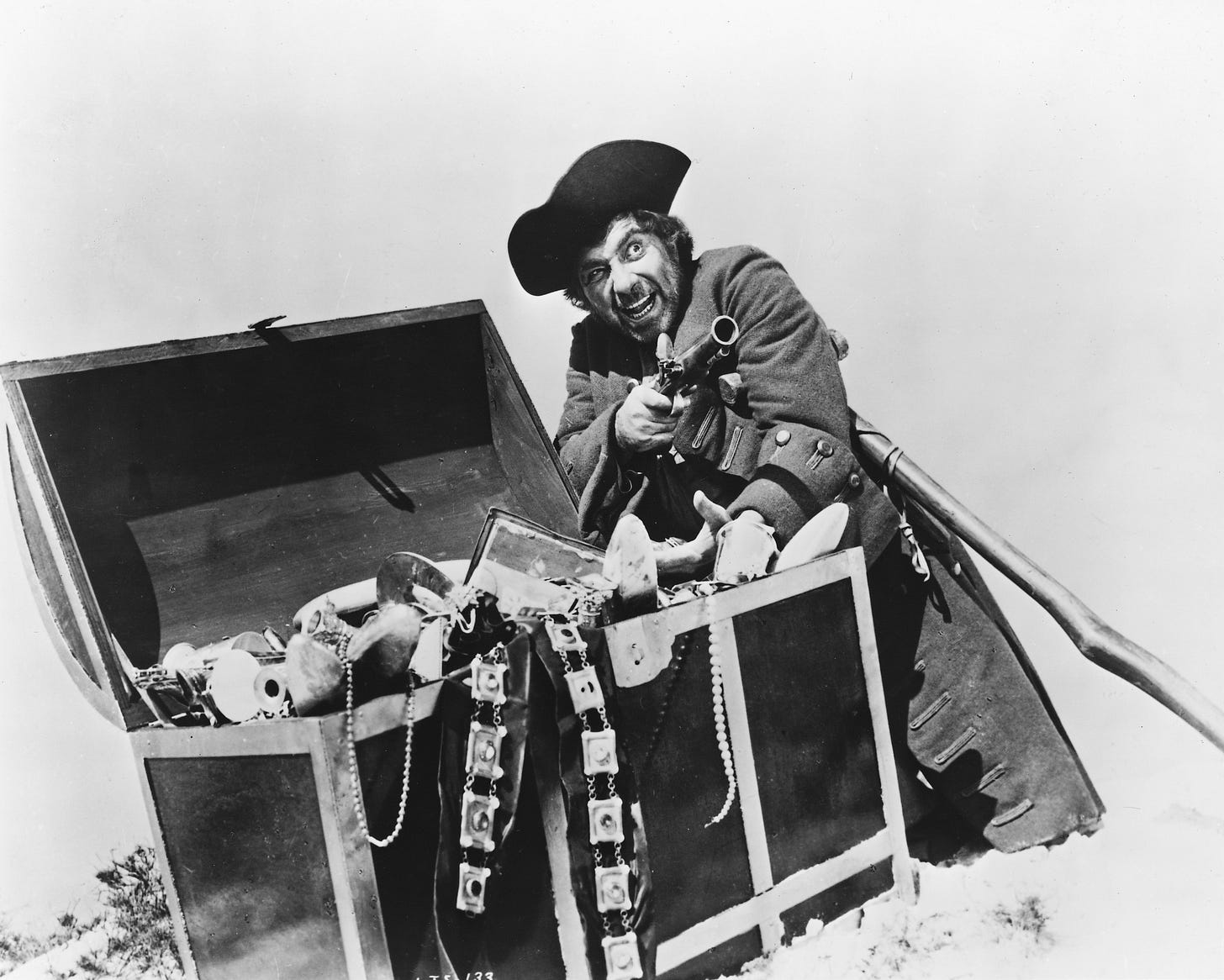Why We Love to Talk Like Pirates
Cultural and literary fascination with buccaneers goes back to when they were still swarming the seas.

Talk Like a Pirate Day, the folk holiday popularized by a Dave Barry column back in 2002, is a weird holiday—even weirder than the obvious talking, dressing, and (for adults) drinking like a pirate. Pirates were violent men (and occasionally violent women) who stole, tortured, raped, and murdered. Yet we celebrate them as lighthearted fun. “Yo ho! Yo ho! A pirate’s life for me!” Not if you wanted to live like a decent person—or for very long.
The most bizarre part, when you think about it, is how pirates are presented as for kids. I have three little ones, and they could watch cartoons about pirates all day long if my wife and I let them. From Peppa Pig to Paw Patrol, Bubble Guppies, and Mickey Mouse Clubhouse, the adventures of these colonial criminals are as ubiquitous as stories about the importance of sharing or going to the dentist.
How did pirates become such a big part of popular culture?
If you’re thinking Disney did it, you’re not wrong. Walt was enamored of pirates. He built the Pirates of the Caribbean ride at Disneyland—the ride that would, decades later, inspire the Johnny Depp movies—and Disney studios was indirectly responsible for creating the idea that pirates shout “arrrr!” all the time. Robert Newton, the actor who played Long John Silver in Disney’s 1950 movie Treasure Island, delivered his lines with a growl, emphasizing the r sounds.
Two years later, Newton starred as the notorious Captain Edward Teach in Blackbeard the Pirate. He gave the character a similarly rough and rumbling voice, although Newton’s Blackbeard sounds like he’s saying “ha-arrrrr” with an h preceding the now famous pirate locution. Ultimately, it’s the last part that stuck: pirates punctuated every sentence with a hearty “arrrr.” Everyone knows that. Even my 3-year-old.
Disney’s efforts point to an even bigger influence on popularizing pirates: Robert Louis Stevenson’s 1883 novel Treasure Island. But Stevenson drew on an already venerable tradition of stories about pirates and buried treasure from earlier in the 19th century. In fact, the early 19th century witnessed a profusion of stories about hunting for pirate treasure. Edgar Allan Poe’s 1843 “The Gold Bug,” about a lost pirate hoard discovered with a cryptograph, is a well-known example. Washington Irving’s “The Money-Diggers” (1824) is less famous, but more typical of the period’s mixture of pirates with tales of ghosts and magic divination.
The fascination with pirate stories goes back to the days when real pirates were still swarming the seas. In the 17th and 18th centuries, for example, people thrilled to reading the exploits of Captain Henry Morgan (later immortalized in the rum) and singing songs about Captain William Kidd.
In 1719, a 13-year-old Benjamin Franklin walked the streets of Boston selling a ballad he wrote called “The Taking of Teach the Pirate.” One stanza recounted how the pirates pledged to blow up their ship rather than surrender:
And when we no longer can strike a blow, Then fire the magazine, boys, and up we go! It’s better to swim in the sea below Than to swing in the air and feed the crow, Says jolly Ned Teach of Bristol.
I’ve pondered the appeal of pirates for nearly 20 years, and I still don’t have a fully satisfactory answer to why people love pirates so much in spite of the gruesome reality.
A few factors, though, seem important.
Although piracy has existed in all times and places, it’s the pirates of the 17th and 18th century Caribbean and Indian Ocean who get the most attention. These pirates carried out their depredations in exotic places, so beautiful that it’s like pirates lived a perpetual vacation—and got rich doing it. It’s easy to forget the harshness of the climate, the cruelty of the men who exploited it, and the likelihood that they would die painfully, at sea or at the end of a rope.
Pirates have also enjoyed unusually good publicity. Treasure Island is one example of the high quality of pirate literature. But it’s far from the only one.
In the late 17th century, The Buccaneers of America gripped Europe with stories told by Alexandre Exquemelin, a surgeon who joined an expedition of buccaneers. Accompanied by vivid engravings, the work offered lurid descriptions of looting, mayhem, and drunkenness too awful to look at . . . but impossible to turn away from.
In the 1720s, a printer named Nathaniel Mist mixed fact with fiction in A General History of the Pyrates and made stars of Blackbeard and two women pirates named Anne Bonny and Mary Read. Both works influenced innumerable other books and movies and remain captivating reads today.
The grim reality of pirate life was forgotten from the start, so it’s no wonder it’s seldom appreciated today.
In the end, Howard Pyle, the early-20th-century author and illustrator of many a book about buccaneers, might have gotten closest to an answer. “Would not every boy,” he asked rhetorically, “rather be a pirate captain than a Member of Parliament?” I’d add girls, too, but Pyle’s right. Today, pirates mean adventure. And it’s fun to say “arrrr!”

